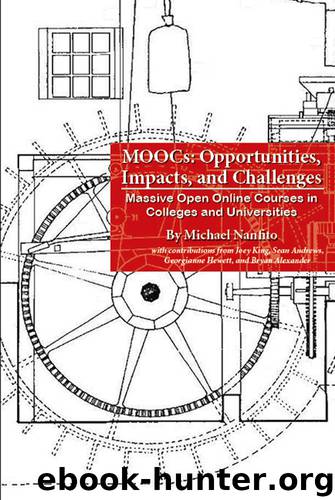MOOCs: Opportunities, Impacts, and Challenges Massive Open Online Courses in Colleges and Universities by Nanfito Michael

Author:Nanfito, Michael [Nanfito, Michael]
Language: eng
Format: epub
Publisher: Unknown
Published: 2013-12-10T16:00:00+00:00
Chapter 7: MOOCs and the Measurement of Knowledge and Competency
The emergence of MOOCs has been and will continue to be a catalyst for more discussions among presidents, provosts, trustees, deans, accrediting agency officials, and others about the quality of MOOC courses, the value of MOOC certificates, and the potential threat that MOOCs offered by elite institutions and their partners like Coursera and Udacity might pose to other segments and sectors. [42]
~ Casey Green
In 2012, Pepperdine University provost Darryl Tippens penned a thoughtful Chronicle of Higher Education essay in defense of the value of residential liberal arts colleges in response to popular enthusiasm for “distance learning.” While declaring the value of liberal education, Tippens noted the extreme variations in higher education in the U.S.: “Higher education is not a single industry producing a single ‘product,’ but an extremely varied enterprise, with more than 4,000 institutions doing different things in different ways, with different ends in mind. The confusion shows up in the debates about whether technology (specifically, distance learning) will ‘save’ us.” [43]
Tippens went on to declare that “reflection and practice together are the best pedagogy.” The togetherness he referenced is the actual , face-to-face gathering of people in synchronous time and space. He also acknowledged that interest in MOOCs was driven in part by faults with the current system of higher education, and concerns of taxpayers called upon to cover its costs. “Anything as sprawling and complex as higher education means that something, somewhere, is being done poorly or flat wrong. Too many professors, schooled in the finest research universities in the world, have learned to scorn teaching and even to view undergraduates as impediments to their professional advancement . . . No wonder some people think that education can be standardized, easily packaged, and cheaply distributed. No wonder taxpayers are less willing to finance the enterprise. As in Hamlet, we are hoist with our own petard.” [44]
In response, Clay Shirky pointed out in a February 2013 essay, “How to Save College,” that Pepperdine students can secure both masters and doctorate degrees from the University while enrolled in its online learning programs. Shirky, to expand on Tippens’s Shakespearian theme, would have us believe that the Pepperdine provost doth protest too much. [45]
Tippens’ essay and Shirky’s response provide an opening to ask more interesting questions about the future of education, the nature of measuring competency, and how hybridized learning spaces of in-person seminars and online essays and exchanges can be explored, developed, and implemented.
As Shirky argues elsewhere in his response, MOOCs and online education have arrived during a time when students and their parents—given economic realities and the finite capacity of the traditional model—are open to new options. Higher education in the U.S. is not a single industry with a single product line. Rather, it is a complex hybridization of intent and implementation loosely held together by adherence to policies and oversight inherited from a previous century. The traditional and the online are destined to blend and coexist rather than battle for market share until one or the other dies off.
Download
This site does not store any files on its server. We only index and link to content provided by other sites. Please contact the content providers to delete copyright contents if any and email us, we'll remove relevant links or contents immediately.
Navigation and Map Reading by K Andrew(5113)
Spare by Prince Harry The Duke of Sussex(5078)
Tuesdays with Morrie by Mitch Albom(4696)
Cracking the GRE Premium Edition with 6 Practice Tests, 2015 (Graduate School Test Preparation) by Princeton Review(4227)
Machine Learning at Scale with H2O by Gregory Keys | David Whiting(4200)
Never by Ken Follett(3801)
Goodbye Paradise(3730)
What It Really Takes to Get Into Ivy League and Other Highly Selective Colleges by Hughes Chuck(3697)
Harry Potter and the Prisoner of Azkaban (Book 3) by J. K. Rowling(3304)
Fairy Tale by Stephen King(3229)
Pledged by Alexandra Robbins(3138)
Kick Ass in College: Highest Rated "How to Study in College" Book | 77 Ninja Study Skills Tips and Career Strategies | Motivational for College Students: A Guerrilla Guide to College Success by Fox Gunnar(3077)
A Dictionary of Sociology by Unknown(3032)
Sapiens and Homo Deus by Yuval Noah Harari(2990)
Reminders of Him: A Novel by Colleen Hoover(2952)
The Social Psychology of Inequality by Unknown(2943)
Graduate Admissions Essays, Fourth Edition: Write Your Way into the Graduate School of Your Choice (Graduate Admissions Essays: Write Your Way Into the) by Asher Donald(2878)
Will by Will Smith(2797)
Zero to Make by David Lang(2727)
